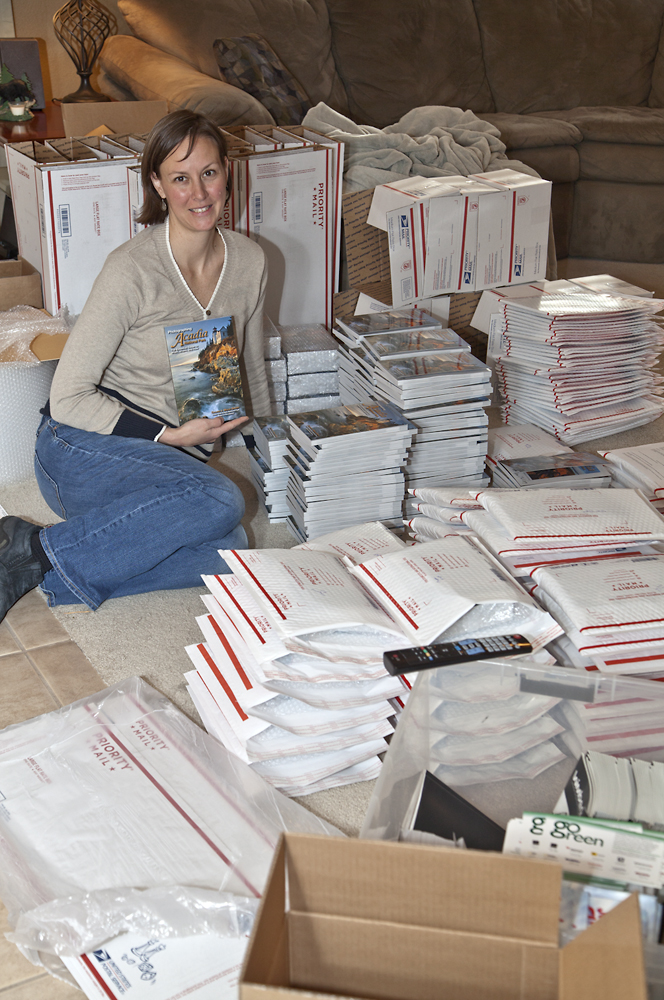Self-Publishing a Book

Dear Bubbles:
Now that I find myself with extra free time these days, I’m considering putting together a book with my photographs and thoughts. I’d want to sell it on Amazon, Barnes & Noble, etc. But I’ve never done anything like this before. I know you’ve written multiple books which I have and are excellent. Could you give me some tips on how to get started with this new project of mine? I’m eager to give it a try. Thanks.
~Jerry
Dear Jerry:
How exciting! Creating a new book seems like a wonderful use of your free time if for no other reason than to learn something new. Plus, we could all use more beauty, knowledge, and entertainment right now.
I absolutely love everything about putting books together. I love watching an idea that once sat in my head turn into a tangible object I can touch and smell. I love working with my teammates, who bring their talents and unique skillsets, to create something I couldn’t possibly achieve on my own. I love the ridiculous amount of scrutiny a book requires on every little detail—comma usage, font size, kerning, leading, color hues, graphic design, paper weight and thickness, consistent placement of the page number on each page—not to mention the writing and photography. It truly is a great outlet for my, and perhaps your, perfectionistic tendencies.
I enjoy the process so much that I started my own publishing company, Analemma Press, in 2011. It started as a self-publishing venue for my own ideas, but has since transformed into a small independent house. So far, we’ve produced four guidebooks and five eBooks. We have at least eight additional titles either underway or on the three-year plan.
In 2010, when I started working on my first book, Wild in Arizona: Photographing Arizona’s Wildflowers with my buddy and fellow photographer Paul Gill, I knew nothing about the production and publication process. We learned every step of the way—and I’ve continued to learn since then with each title.

You might be eager to jump right into creating your book. If your intentions are to self-publish and sell your book, I encourage you to do some researching, thinking, and planning before pouring your energy, time, and money into it. Specifically:
Scrounge up a copy of Dan Poynter’s book, The Self Publishing Manual. Poynter died in 2015, but not before cranking out at least 16 editions (!!!) of this guide. It hasn’t been revised recently for obvious reasons, so some of the information is slightly dated. Still, if there’s a Bible to self-publishing, this is it. Poynter walks readers through the entire process from writing salable content to selling your finished product. I’ve referenced it countless times to remind myself of the critical details of each step and to get new ideas for future projects.
Complete a marketing analysis before you pen a single word or place a single photo. I know we’d all like to believe that everyone in the world will love and buy what you write and photograph. But consider this: The Lord of the Rings by J.R.R. Tolkien has sold approximately 150 million copies since 1954. The Harry Potter series (a collection of seven books) by J.K. Rowling has sold 500 million copies. As of last measure, 7.8 billion people exist in the world. I’m not great at math, but I can tell you, not “everyone” has loved or bought the world’s most popular books. I’m not suggesting that there isn’t a Tolkien or Rowling among us. In a 2016 study, though, Publisher’s Weekly, suggested the average U.S. nonfiction book sold less than 250 copies per year and less than 2,000 copies over its lifetime.
Give yourself a healthy reality check: conduct a market analysis before you do any work on your book. Determine your sales environment, potential profitability, and, thus, your print run quantity based on the size of your target audience. Consider your answers to the following questions:
- Who’s the primary target audience for this type of book? What are their demographics? Male or female? How old? Where do they live? What is their occupation and income? What are their interests? The more specific you are in defining your audience, the easier it’ll be to find them when you set out to sell the book.
- How big is the pool of potential buyers and where will you find them? For a photography-related book, camera clubs, photography conferences, and camera shops come to mind. Consider national and regional outlets, but don’t overlook resources in your own local community who will be eager to help a local author.
- Are there other existing books like it? What has the competition done? When was a competitor’s book last published? How well is it doing in the marketplace? What do you like/don’t like about their product? How will your book serve a different need/purpose?
- What is the target price? Is it a price the market will bear? (I.e., Does the disposable income level of your target audience enable them to buy your book at this price point?)
- What’s the anticipated profit margin based on the cost of printing, selling, and all the little business tasks (e.g. accounting, inventory management, acquiring the ISBN and bar codes, storage rentals)?
- What are the specific marketing tactics you will use to reach your target audience?
Clarify your vision. What value will your book bring to readers? What benefits will they get by reading it? What problems can you solve for them with your book? Will it be educational, entertaining, inspirational? Determine the goal of your book. Define what’s in scope and out of scope for your title. Complete a high-level outline of topics. Once you’ve done this, revisit your marketing analysis to confirm your target audience wants or needs this type of book.
Choose printed book, eBook, or both. If your book serves as a reference guide (e.g. travel guides), consider both a print and e-version of your publication. If your book will likely be read once on an airplane (e.g. novels), consider publishing an eBook only, unless you have substantial funding available to print, established distribution channels, and a large, interested audience. eBooks presents a lower financial risk than printed copies.

Deliver the highest quality product you possibly can. Write the book you’d like to read. An effective cover grabs a potential reader while the text on the back cover closes the sale. Don’t skimp on either! Hire a professional graphic designer for layout and design. Leverage the services of a keen editor who can assist with not only checking grammar and proof-reading (and commas, my nemesis!), but also in developing your narrative and flow. Utilize a focus group, comprised of people from diverse backgrounds, to test various design and content ideas before you finalize your approach. Incorporate their feedback, but stay true to your vision.
Prep your book for retail sales. If you have any notions of selling your book in a retail store, you must place a bar code on the back cover. You also must possess an ISBN which is like a social security number for your title. The ISBN goes on your Library of Congress page (after your inside title page). Visit www.bowker.com to get both. Along with the ISBN listing on your Library of Congress page, you’ll also need a Library of Congress Control Number (LCCN). To do so, self-publishers go through the Pre-Assigned Control Number (PCN) process: www.loc.gov/publish/pcn
Create professional-quality marketing materials. Create a website (and blog, if appropriate) dedicated to your book. Prepare bookmarks, postcards, and handouts/flyers to distribute at all book signing events, workshops, presentations, etc. Study Seth Godin’s This Is Marketing: You Can’t Be Seen Until You Learn to See for insights on how marketing works. In addition, Jay Conrad Levinson’s book Guerrilla Marketing all offers a multitude of potential—and somewhat unconventional—marketing tactics.
Select a printer. Print-on-demand (POD) printing is not always cost-effective, but offers smaller print runs and the flexibility to print more or less as demand fluctuates. (For example, to print our wildflower book with POD printers, it would have cost me around $84.00. Given we’d sell the book for $24.95, well, you do the math.)
Offset printing is the most logical choice for higher print runs (1,000+ copies). Get recommended contacts from other self-publishers. Solicit multiple competitive bids from printers from international and U.S.-based companies. Ask not only about the printing pre-press, production, and transportation costs at varying print run quantities, but also the fees for changes you will inevitably make during the activities leading up to the final printing. Request samples of their paper stock to evaluate the quality especially if you intend to include photographs in your book. Call the references provided by the printer. Ask questions like, “Did the printer adhere to your requirements? Did they meet deadlines? Were they communicative during the printing process?”
When we worked through this assessment, we found printing overseas was only $0.14/book cheaper than printing in the U.S. Considering language barriers, transportation challenges, and our desire to keep the printing in the country, we chose Bang Printing. They are headquartered in Minnesota. We’ve had books printed there and in their California facilities.
Raise funds to support your printing costs. Printing hard cover or paperback books will cost thousands of dollars—by far the biggest expense in producing a printed title. Tap into logical corporate sponsorships in exchange for providing them advertising to your target audience. In addition, conducting a crowd-funding campaign through platforms like Indiegogo and Kickstarter. These short-lived campaigns generate excitement for your forthcoming book and facilitate pre-orders that can raise funds for printing.

Define your distribution plan. Getting into big box stores like Barnes and Noble is a common goal for many-a-author. It’s not one of mine. It’s not where my target audience buys books. Even if they did, the chances of them finding my one 6”x9” guidebook among the thousands of books on the shelves are minuscule. (It’s even less if the buyer doesn’t know your book exists before they walk into the store).
Seth Godin wrote that the two places to sell books are direct to customers through events and Amazon. While we do sell our books at camera stores, gift shops, museum stores, visitor centers, and other retail outlets, the bulk of our sales indeed come from those two sources. Connecting with your target audience at presentations, book signings, and workshops is most profitable—and for me, it’s also the most fun. Social media and email newsletters can keep your community interested and engaged.
To sell at stores, you can contact a distributor, who will distribute the book for you, or distribute it yourself. Distributors will keep a cut, typically around 20% of your “Manufacturer Suggested Retail Price” (MSRP, or your book’s price). Whether you sell direct or through a distributor, retail outlets will take an additional 40 to 60% discount off of MSRP for their efforts. If you decide to distribute yourself (which requires cold calling locations one by one), ensure you document a Retail Agreement that outlines your discount, shipping terms, payment terms, and return policy—and get it signed by your retail partner.
Navigating Amazon’s distribution process was an exercise in patience. They offer multiple programs with multiple requirements and multiple delivery mechanisms. In a word, chaos. We ultimately settled on the Amazon Advantage program for our books.
I know many people dislike Amazon due to their practices. I can’t say I’m impressed with how they treat me as a publisher. We would lose sales, though, if we chose to not work with them. Put it this way, working with Amazon is a little like eating mushy Brussel sprouts. You know they’re good for you even if they taste bad. Since I’m aware of the behind-the-scenes dealings as publisher and author, when I put on my consumer hat, I try to buy books direct from authors or from local book stores where I know authors get a bigger cut of the profit.
I’d add one more important distribution channel whether you work with a distributor or distribute yourself: your or your book’s website where you can offer signed copies.

Decide how you will ship the books to direct customers. Determine where you will store your books (e.g. in your garage, in a storage facility, at your printer’s warehouse, at your distributor’s storage house) so you know what access you have to your inventory for shipping purposes. Using mail media rate offers the cheapest—albeit the slowest—method to ship. However, the package cannot contain advertising (according to the USPS, “incidental book announcements” are acceptable). USPS’ flat-rate priority mail offers a pricier, but faster alternative. It also includes tracking capabilities so you can confirm delivery. For eBooks, shipping occurs over the internet. Enable web-based ordering and file deliver to your customers via digital download services like eJunkie (which works with Paypal).
Celebrate your success! Host a book release party to recognize the contributions of your team, sponsors, and dedicated supporters. Plus, you deserve to relax and raise a glass to your big accomplishment!
Now, if all of this sounds like an incredible amount of work…it is. I’m not going to sugarcoat the realities of bringing a book to life. It’s also an incredible amount of time. When you include the photography and writing (from captions to content to the Library of Congress page), a book could take years to materialize.
Paul and I worked tirelessly for 18 months to put together the first edition of the Wild in Arizona: Photographing Arizona’s Wildflowers—and that was after Paul had photographed wildflowers for 30-plus years and me 10. I completed the Photographing Acadia National Park guidebook in 12 months after photographing in Acadia for 5 years. In hindsight, I rushed the process, and it led to avoidable mishaps. Thankfully, though, the experience taught me an important lesson, which is now an informal motto for my publishing company: Make it right, not fast.
A book lasts forever. Oftentimes, like with the adventure travel memoir I’ve been working on now since 2015 (Going with the Flow), you don’t get a second chance to get it right. There are no second editions in creative nonfiction. Fiction either. Second printings can address minor things like grammar and punctuation issues, but they can’t fix a poor story plot, lack of character development, or an uninteresting voice. Make it right, not fast.
If you wish to create a book but are concerned with the associated responsibilities, check out publishing service companies like Kindle Direct Publishing through Amazon, IngramSpark, and Inkshares. Each can help with some or all of these tasks in varying degrees. For a price, of course. These outfits were not available options when I started working on my first book. Had they been, they could have offered a rookie much-needed guidance through the publication system. That said, I wouldn’t change a thing about my journey.
Here’s hoping this information gives you the start of yours, Jerry. Good luck! Please save me a signed copy when your book is published!
Be well, be wild,
~Bubbles
Have a question about photography, art, and/or the creative life? Need some advice? Send your question to Dear Bubbles at colleen@colleenminiuk.com to be possibly featured in a future column post. (If you’d prefer a different display name than your real first name, please include your preferred nickname in your note.)




